Experimental Research on Water Droplet Erosion Resistance Characteristics of Turbine Blade Substrate and Strengthened Layers Materials
Abstract
:1. Introduction
2. Experimental Procedures
3. Experimental Parameters and Results
3.1. Test Condition and Parameters
3.2. Test Results
4. Conclusions
- 1)
- After solid solution strengthening, the sample hardness has been increased and the WDE resistance has been significantly improved. However, according to the metallographic analysis, there is a suspected honeycomb defect in the strengthened region, which may limit the further improvement of the WDE resistance.
- 2)
- At the same impact angle, the WDE resistance characteristics of martensite substrate, solution strengthening, laser cladding and stellite alloy samples are in order from excellent to inferior: brazed stellite alloy, laser cladding, solid solution strengthening and martensite substrate. Laser cladding and stellite alloy materials have excellent WDE resistance. Combined with the micro Vickers hardness test, it is fully indicated that the hardness parameter is not the decisive factor of WDE resistance of brazed stellite alloy.
- 3)
- Furthermore, the WDE resistance mechanism and the failure mode of brazed stellite alloy have been revealed. It is found that the cracks in the erosion damage zone are initiated at the interior and boundary of the hard carbide precipitates. And the cracks expanded along the direction of the carbides. Under the continuous droplet impact, cracks grow and connect into networks, resulting in the removal of carbide precipitates and WDE damage. It is proved that the properties of the Co-based material itself is the reason for its excellent WDE resistance, and the carbides have almost no positive contribution to its anti-erodibility.
Author Contributions
Funding
Conflicts of Interest
References
- Hesketh, J.; Walker, P.J. Effects of Wetness in Steam Turbines. Proc. Inst. Mech. Eng. Part C J. Mech. Eng. Sci. 2005, 219, 1301–1314. [Google Scholar] [CrossRef]
- Crane, R. Droplet deposition in steam turbines. Proc. Inst. Mech. Eng. Part C J. Mech. Eng. Sci. 2004, 218, 859–870. [Google Scholar] [CrossRef]
- Heymann, F. Liquid Impingement Erosion; ASM International: Materials Park, OH, USA, 1992. [Google Scholar]
- Gardner, G.C. Events Leading to Erosion in the Steam Turbine. Proc. Inst. Mech. Eng. 1963, 178, 593–601. [Google Scholar] [CrossRef]
- Carter, T.J. Common failures in gas turbine blades. Eng. Fail. Anal. 2005, 12, 237–247. [Google Scholar] [CrossRef]
- Mahdipoor, M.; Kirols, H.; Kevorkov, D.; Jedrzejowski, P.; Medraj, M. Influence of impact speed on water droplet erosion of TiAl compared with Ti6Al4V. Sci. Rep. 2015, 5, 14182. [Google Scholar] [CrossRef]
- Kirols, H.; Kevorkov, D.; Uihlein, A.; Medraj, M. The effect of initial surface roughness on water droplet erosion behaviour. Wear 2015, 342, 198–209. [Google Scholar] [CrossRef]
- Mahdipoor, M.; Tarasi, F.; Moreau, C.; Dolatabadi, A.; Medraj, M. HVOF sprayed coatings of nano-agglomerated tungsten-carbide/cobalt powders for water droplet erosion application. Wear 2015, 330, 338–347. [Google Scholar] [CrossRef]
- Tarasi, F.; Mahdipoor, M.S.; Dolatabadi, A.; Medraj, M.; Moreau, C. HVOF and HVAF Coatings of Agglomerated Tungsten Carbide-Cobalt Powders for Water Droplet Erosion Application. J. Therm. Spray Technol. 2016, 25, 1711–1723. [Google Scholar] [CrossRef]
- Smith, A.; Caldwell, J.; Pearson, D.; McAllister, D.H.; Christie, D.G. A discussion on deformation of solids by the impact of liquids, and its relation to rain damage in aircraft and missiles, to blade erosion in steam turbines, and to cavitation erosion—Physical aspects of blade erosion by wet steam in turbines. Philos. Trans. R. Soc. London. Ser. A, Math. Phys. Sci. 1966, 260, 209–219. [Google Scholar] [CrossRef]
- Hattori, S.; Kakuichi, M. Effect of impact angle on liquid droplet impingement erosion. Wear 2013, 298, 1–7. [Google Scholar] [CrossRef]
- Xie, Y.-H.; Wang, Y.; Chen, J.-H.; Zhang, D. Numerical and Experimental Study on Mechanism of Material Damage by High Speed Liquid-solid Impact. Proc. CSEE 2009, 35, 019. [Google Scholar]
- Xu, W.; Wang, J.; Qin, L.; Chen, H.; Chen, D. Investigation of Erosion Damages Induced by Wet Steam Containing Micro-Particles. Tribol. Lett. 2010, 39, 115–120. [Google Scholar] [CrossRef]
- Wanli, X.; Li, Q.; Haosheng, C.; Darong, C. Erosion and abrasion on mild carbon steel surface by steam containing SiC microparticles. Wear 2010, 268, 1547–1550. [Google Scholar] [CrossRef]
- Xu, W.L. Research on Mechanism of Erosion Induced by Wet Steam. Ph.D. Thesis, Tsinghua University, Beijing, China, 2010. [Google Scholar]
- Oka, Y.; Miyata, H. Erosion behaviour of ceramic bulk and coating materials caused by water droplet impingement. Wear 2009, 267, 1804–1810. [Google Scholar] [CrossRef]
- Thomas, G.P.; Brunton, J.H. Drop impingement erosion of metals. Proc. Roy. Soc. London. Ser. A 1970, 314, 549–565. [Google Scholar]
- Ahmad, M.; Casey, M.; Sürken, N. Experimental assessment of droplet impact erosion resistance of steam turbine blade materials. Wear 2009, 267, 1605–1618. [Google Scholar] [CrossRef]
- Heymann, F. Toward Quantitative Prediction of Liquid Impact Erosion. In Characterization and Determination of Erosion Resistance; American Society for Testing and Materials: West Conshohocken, PA, USA, 1970; pp. 212–243. [Google Scholar]
- Antony, K.C. The effect of composition and microstructure on cavitation erosion resistance. In Proceedings of the 5th International Conference on Erosion by Liquid and Solid Impact, Cambridge, UK, 3–6 September 1979. [Google Scholar]
- Jeong, C.K.; Kim, W.W.; Rhee, C.K.; Lee, W.J. Investigation of liquid impact erosion for 12Cr steel and Stellite 6B. J. Nucl. Mater. 1998, 257, 134–144. [Google Scholar] [CrossRef]
- Graham, A.H.; Youngblood, J.L. Work strengthening by a deformation-induced phase transformation in “MP alloys”. Met. Mater. Trans. A 1970, 1, 423–430. [Google Scholar] [CrossRef]
- Woodford, D.A. Cavitation-erosion-lnduced phase transformations in alloys. Met. Mater. Trans. A 1972, 3, 1137–1145. [Google Scholar] [CrossRef]
- Rémy, L.; Pineau, A. Twinning and strain-induced F.C.C. → H.C.P. transformation on the mechanical properties of Co-Ni-Cr-Mo alloys. Mater. Sci. Eng. 1976, 26, 123–132. [Google Scholar] [CrossRef]
- Vaidya, S.; Mahajan, S.; Preece, C.M. The role of twinning in the cavitation erosion of cobalt single crystals. Met. Mater. Trans. A 1980, 11, 1139–1150. [Google Scholar] [CrossRef]
- Heathcock, C.; Ball, A.; Protheroe, B. Cavitation erosion of cobalt-based Stellite® alloys, cemented carbides and surface-treated low alloy steels. Wear 1981, 74, 11–26. [Google Scholar] [CrossRef]
- Preece, C.; Vaidya, S.; Dakshinamoorthy, S. Influence of Crystal Structure on the Failure Mode of Metals by Cavitation Erosion. In Erosion: Prevention and Useful Applications; American Society for Testing and Materials: West Conshohocken, PA, USA, 1979; pp. 409–433. [Google Scholar]
- Mousson, J. Pitting resistance of metals under cavitation conditions. ASME TRANS 1937, 59, 399–408. [Google Scholar]
- Robinson, M.J.; Hammitt, F.G. Detailed Damage Characteristics in a Cavitating Venturi. J. Basic Eng. 1967, 89, 161–173. [Google Scholar] [CrossRef]
- Preece, C.M. Treatise on Materials Science and Technology; Academic Press: Cambridge, MA, USA, 1979. [Google Scholar]
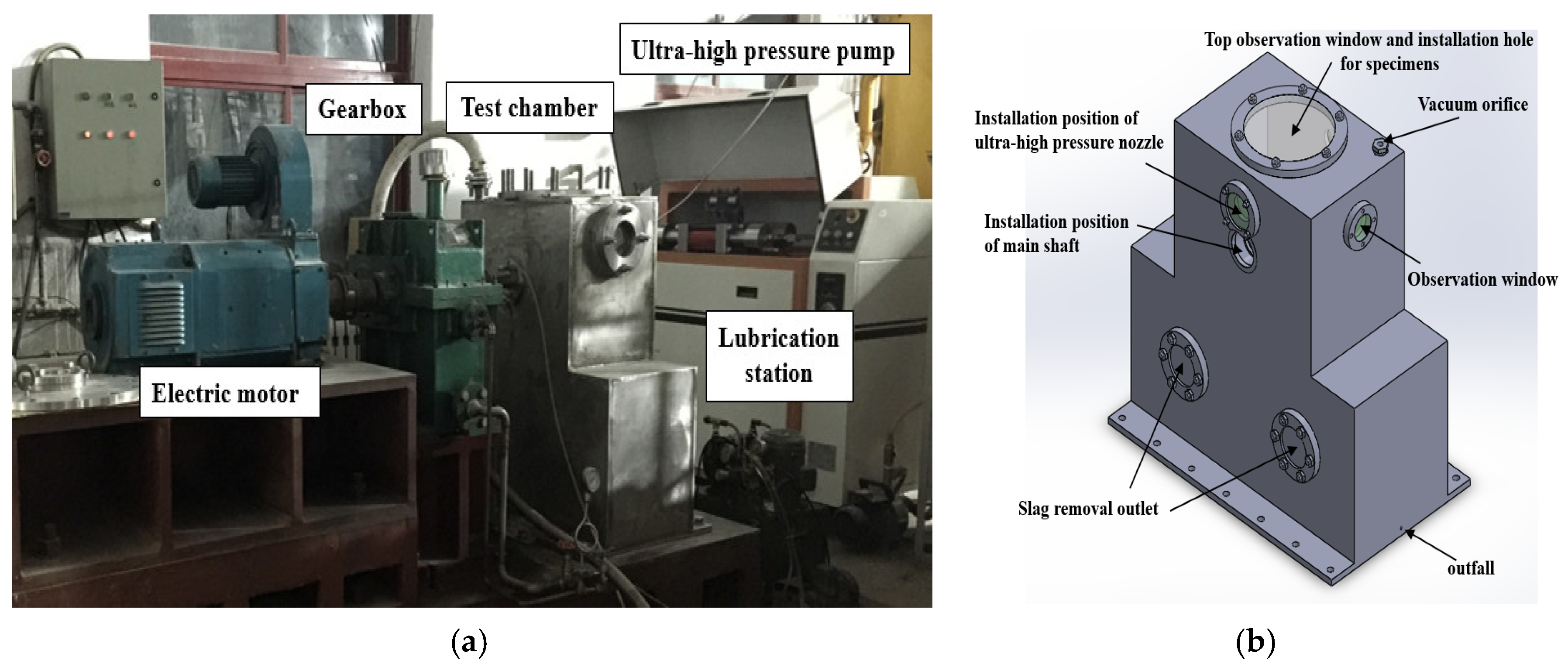
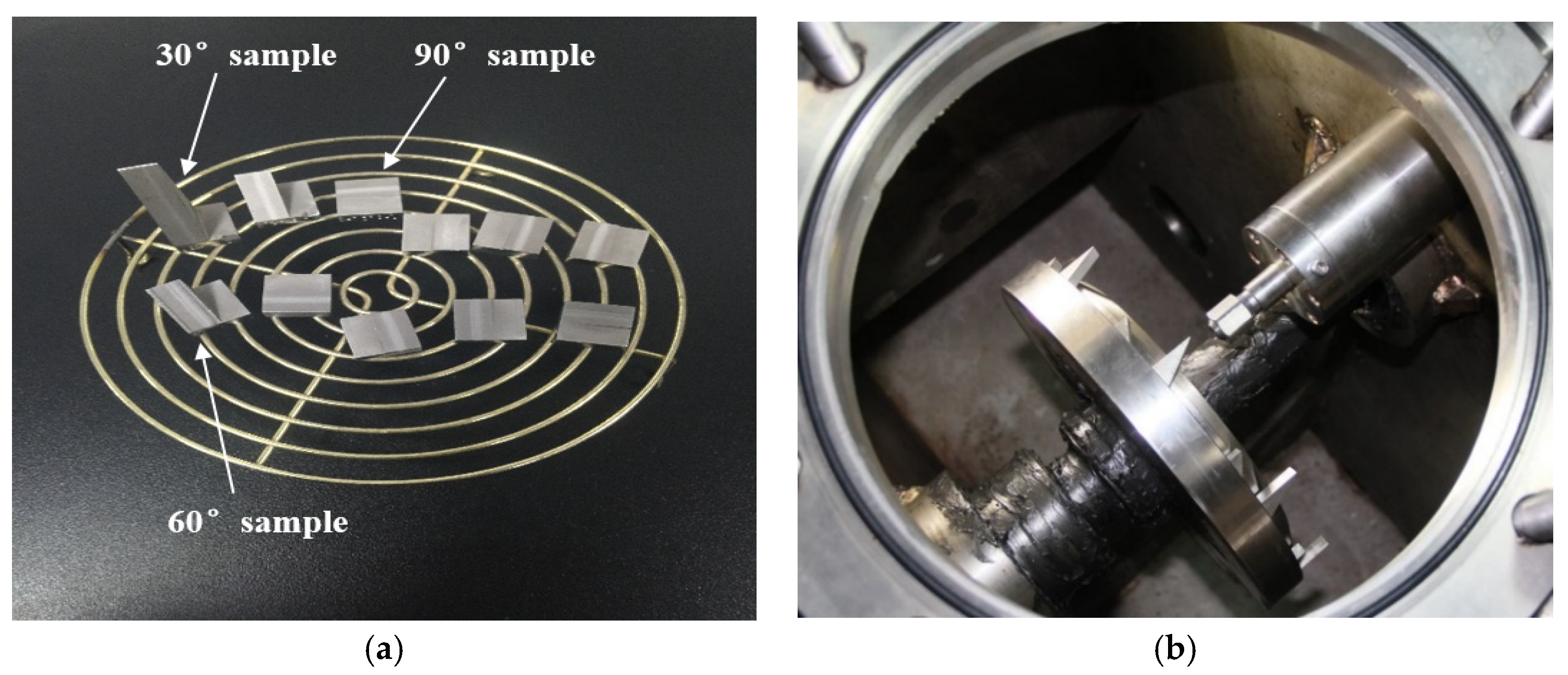
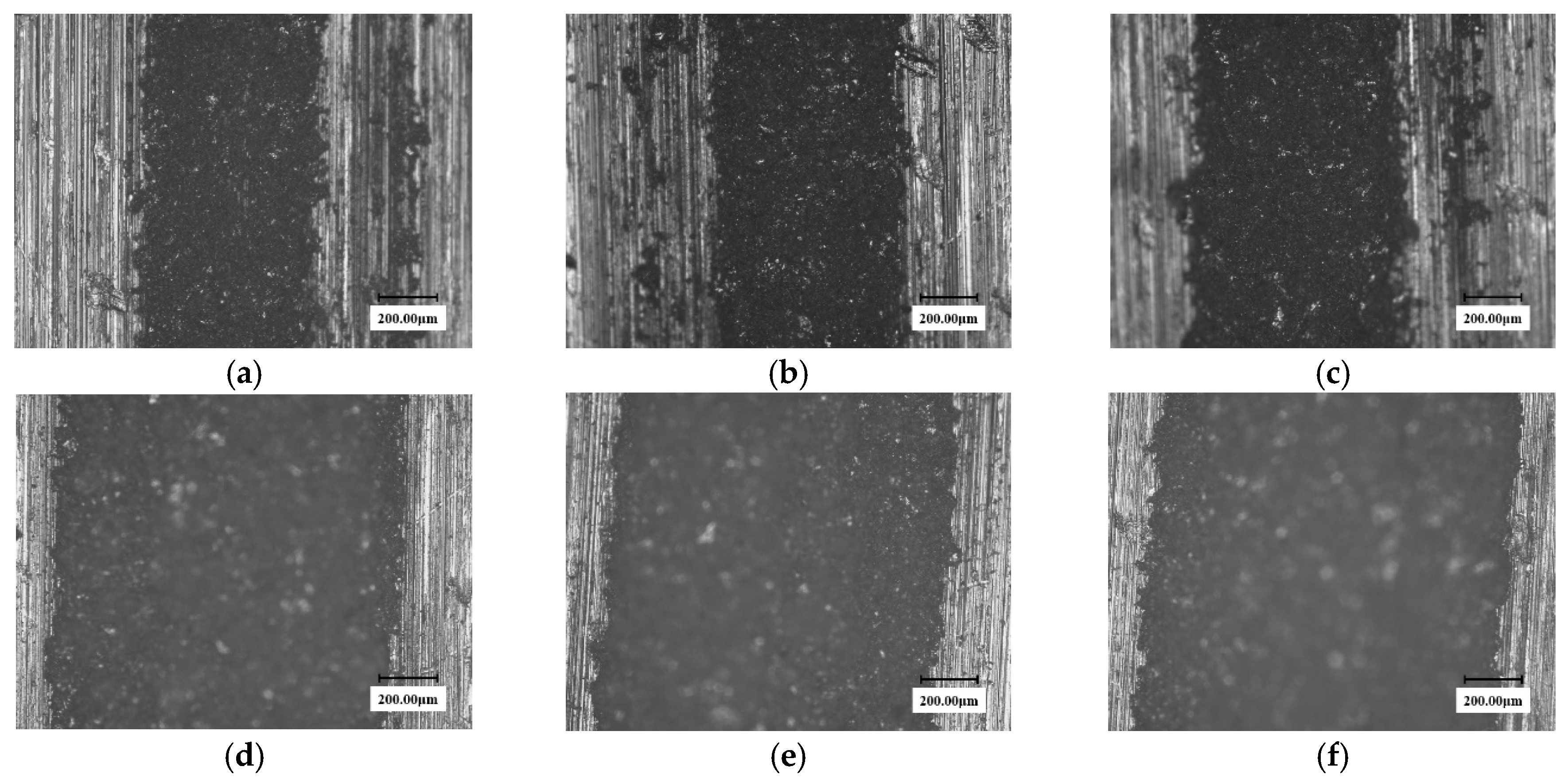
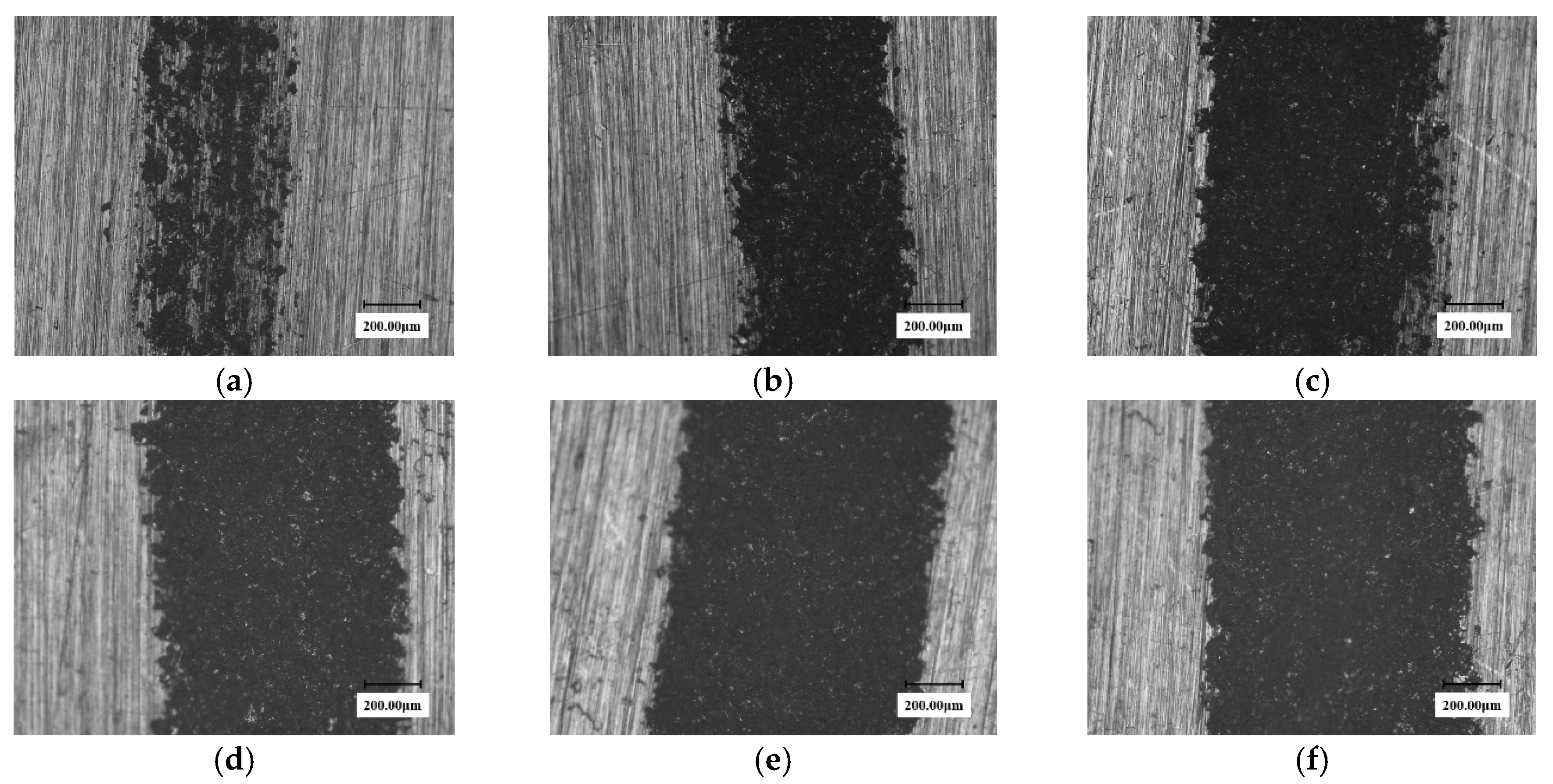
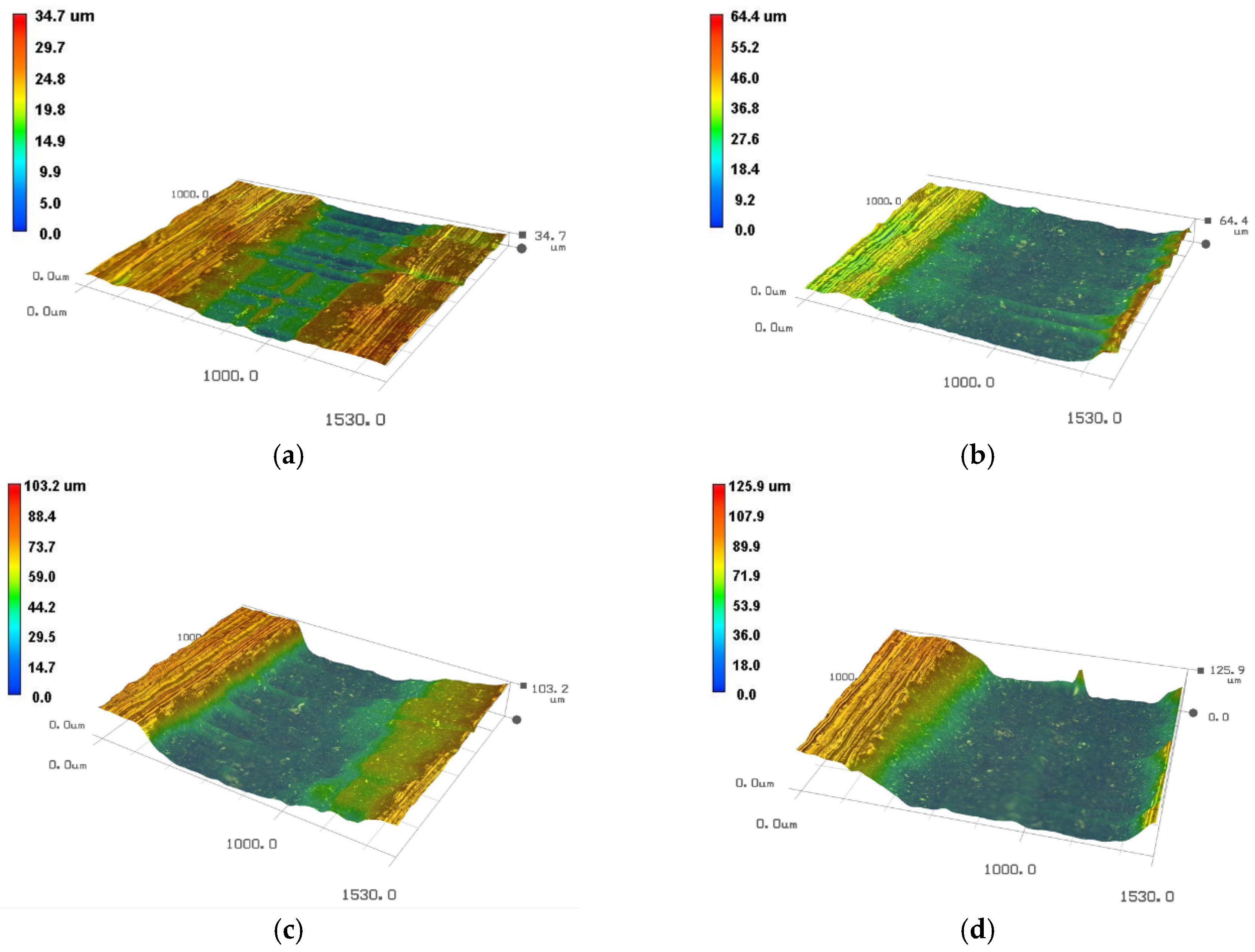
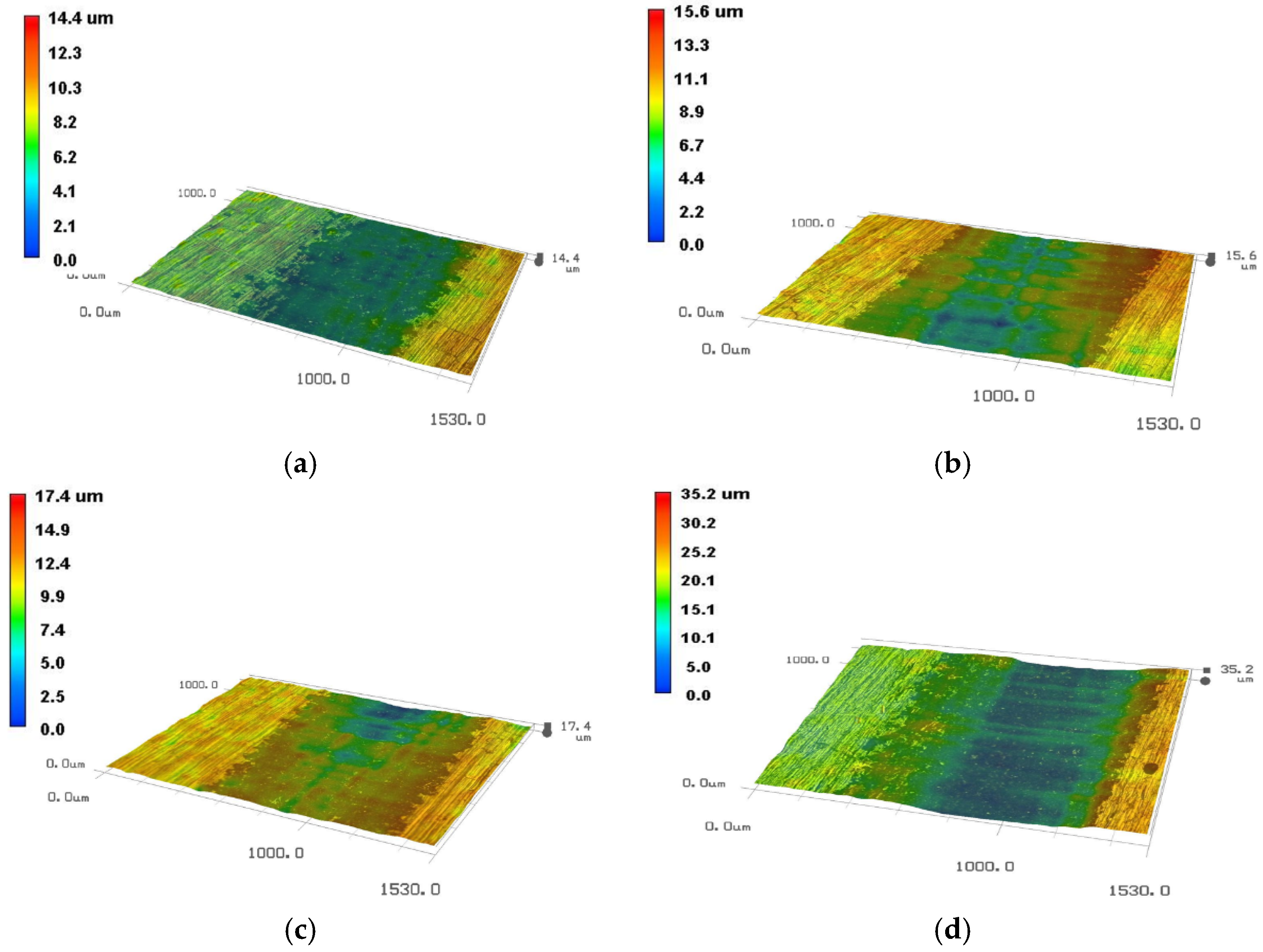
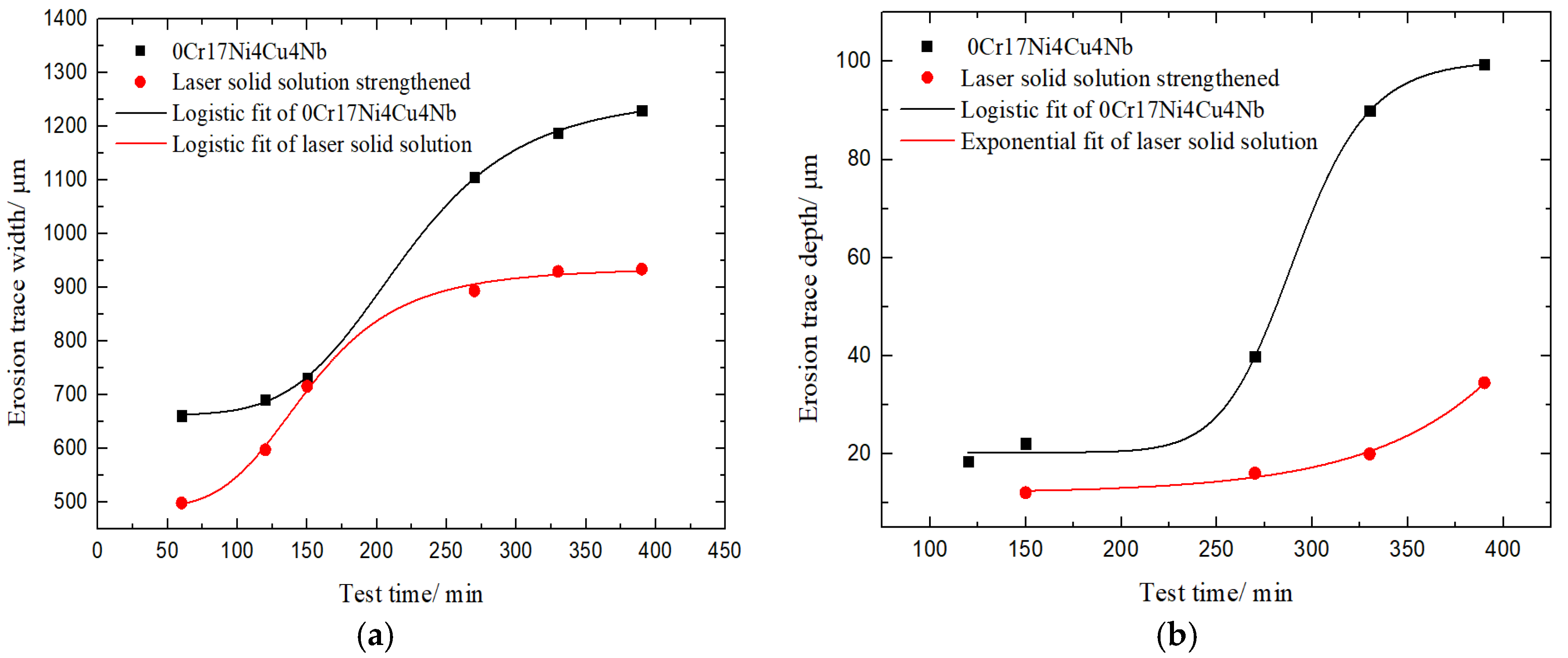

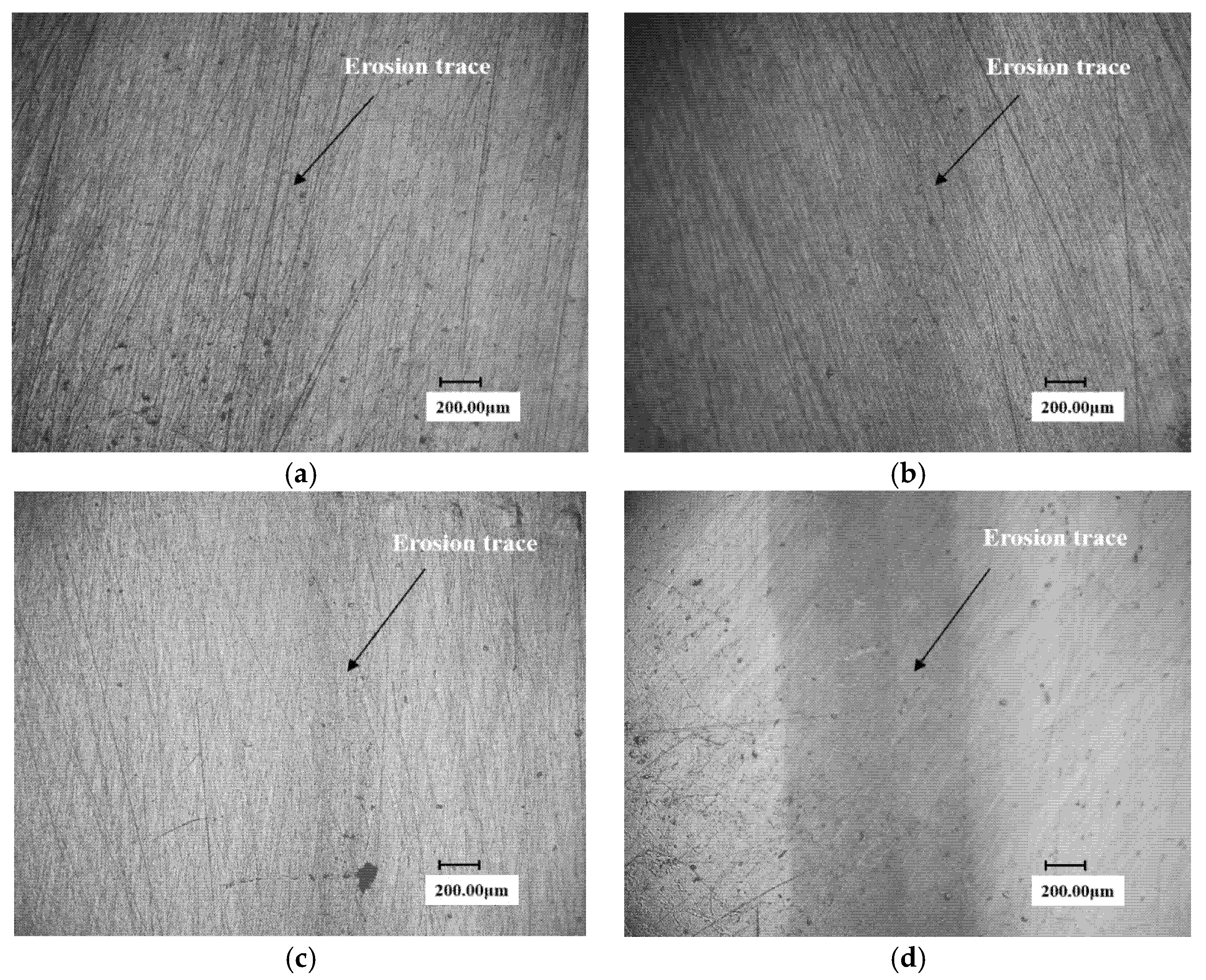
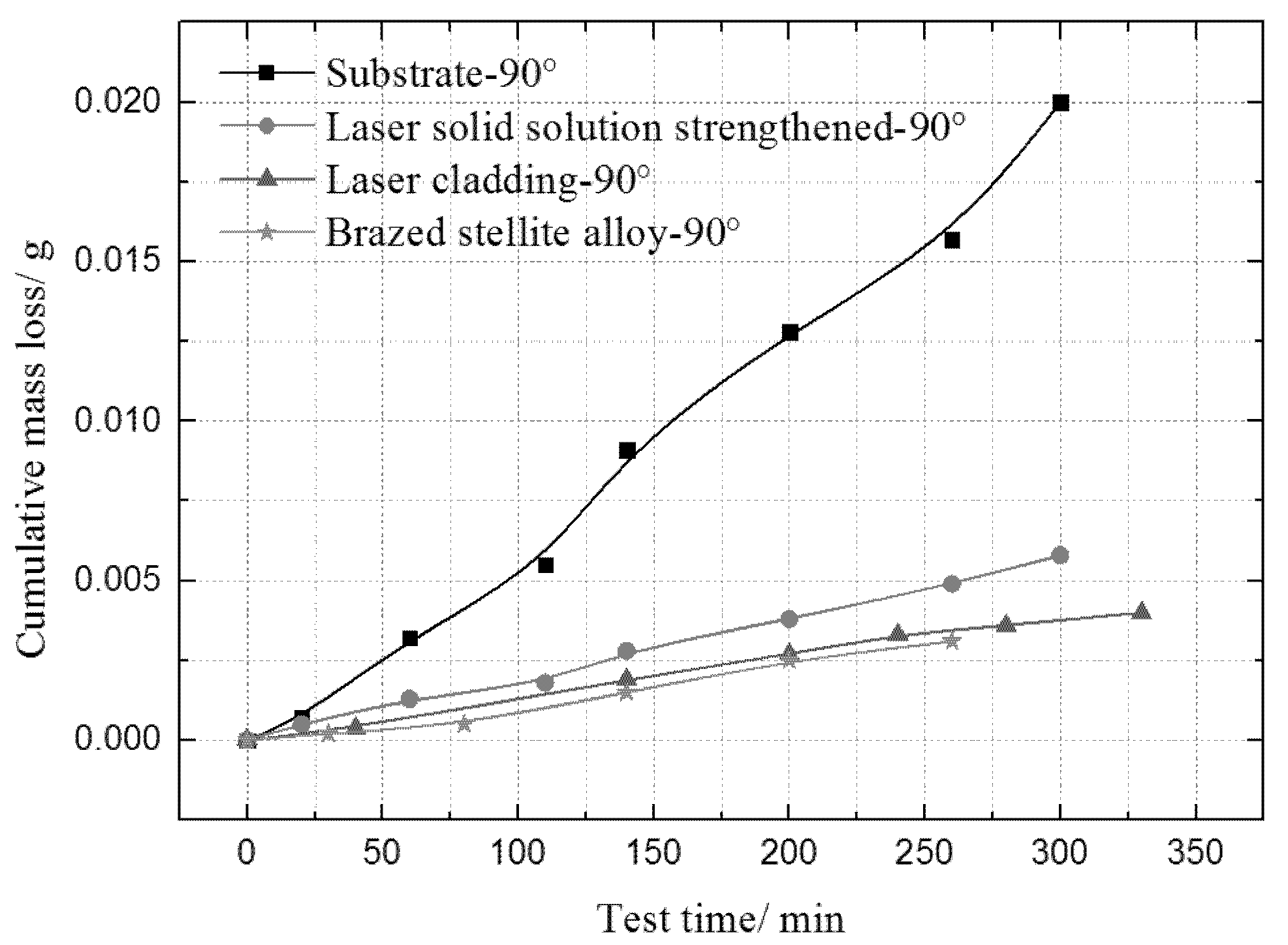
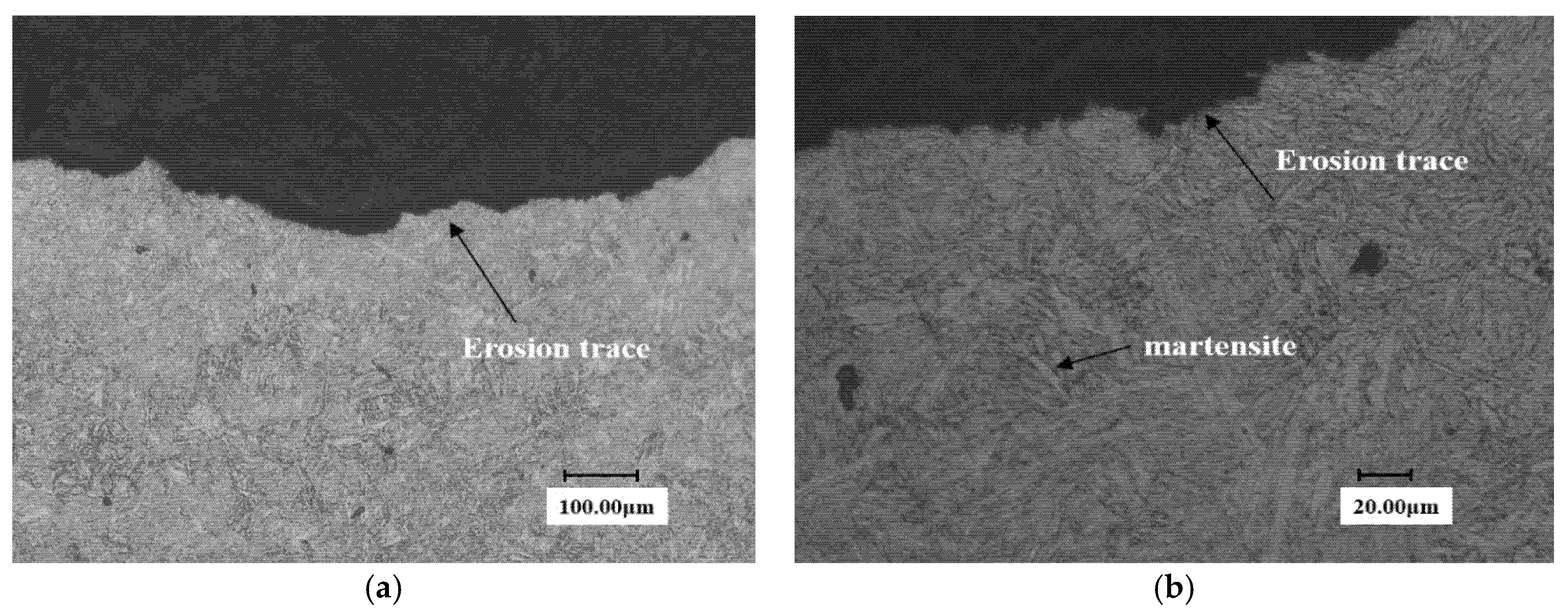

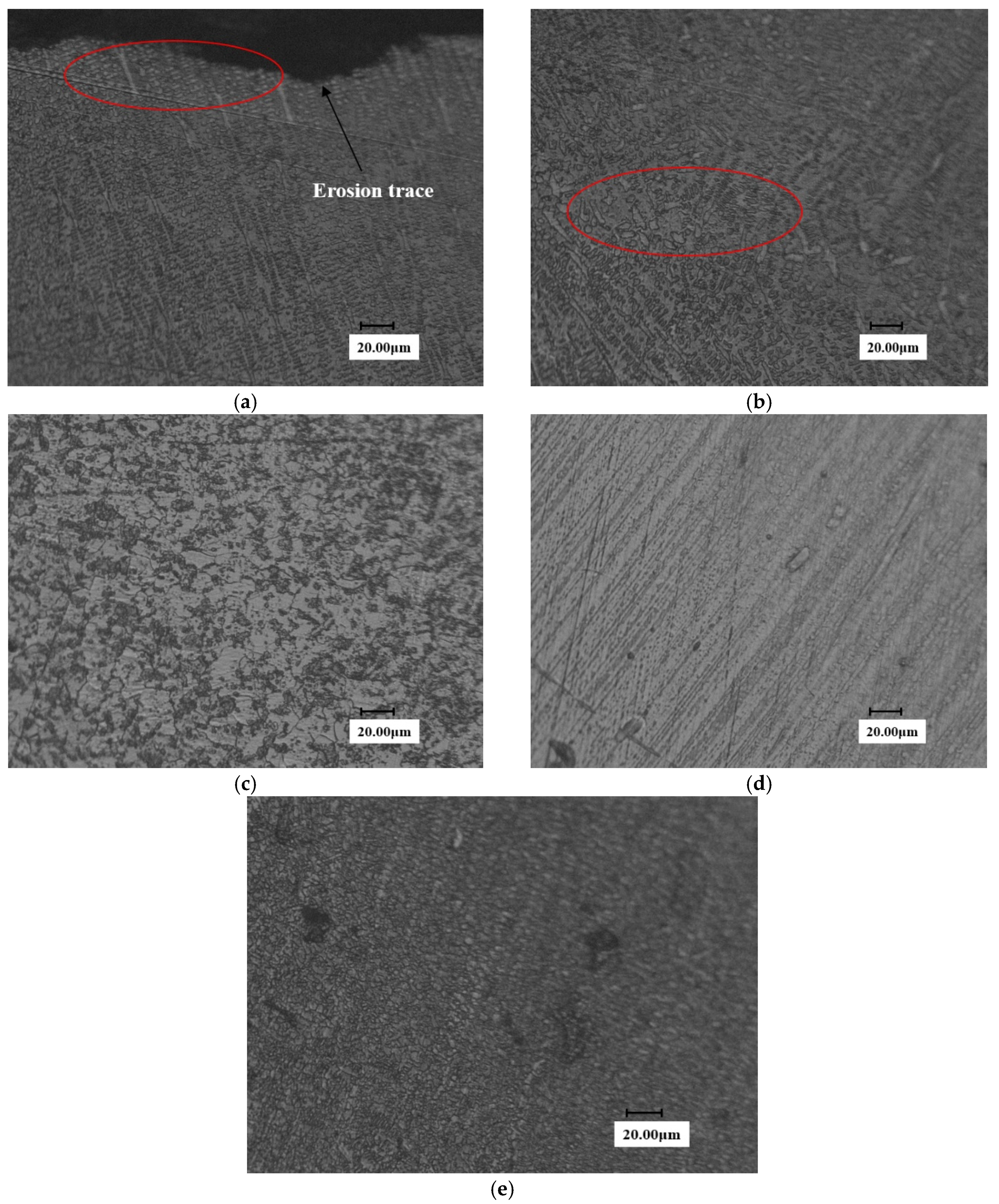


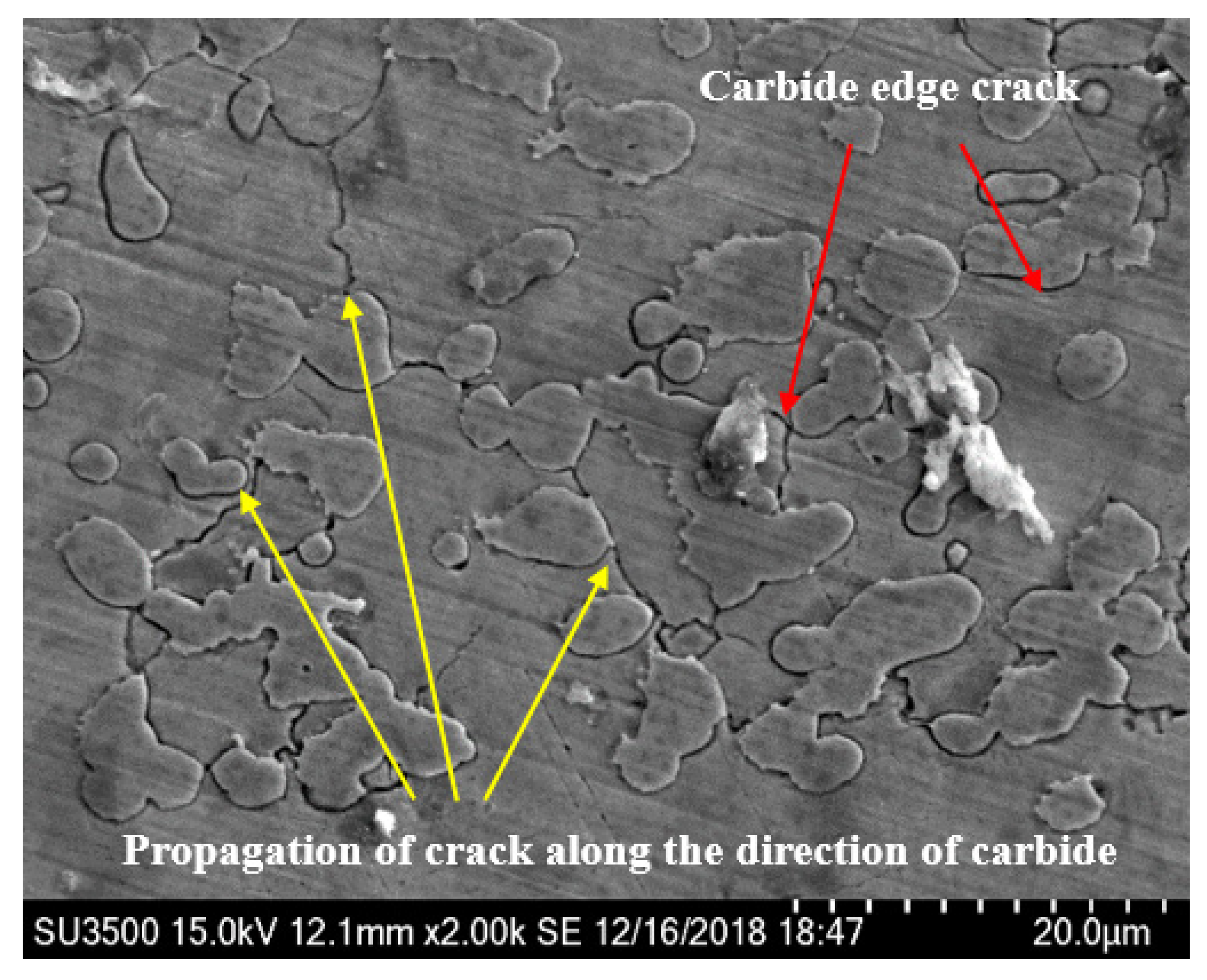
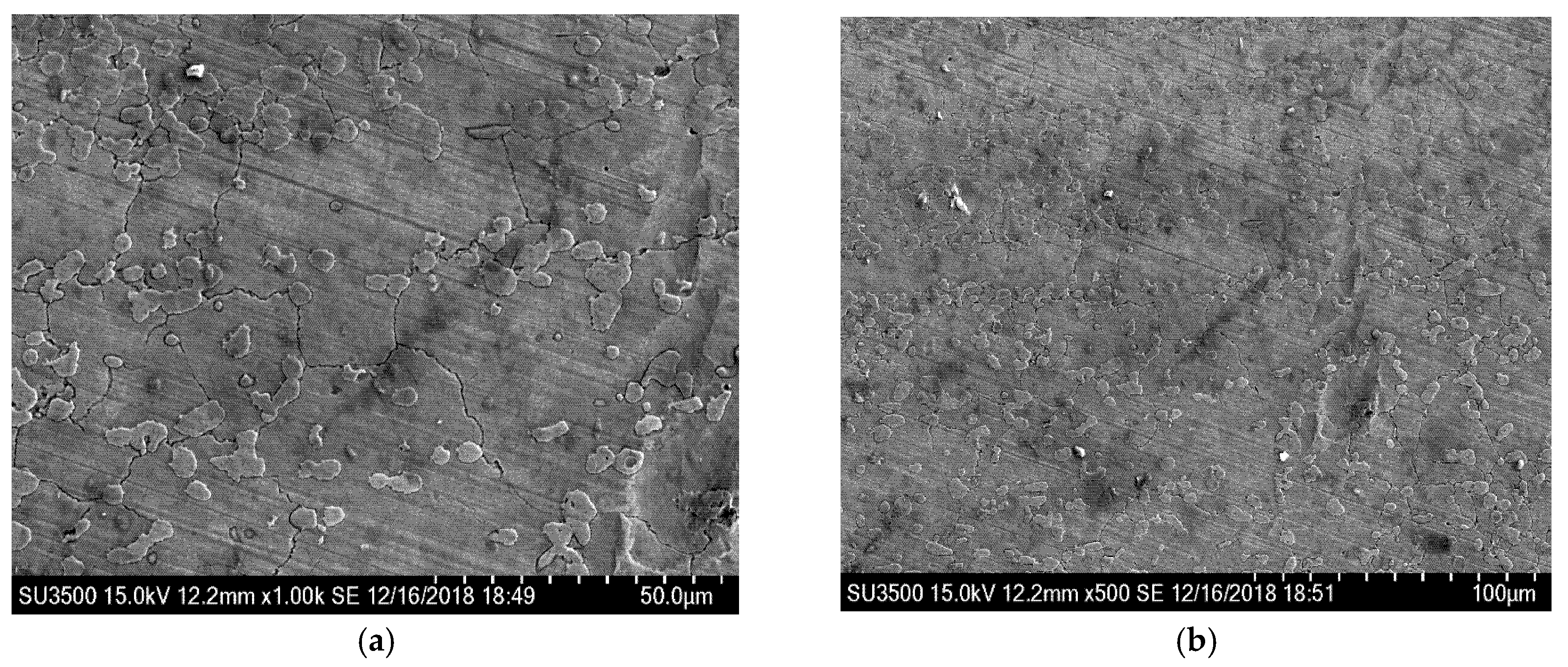
| Samples | V0/m·s−1 | θ/° | Nozzle Diameter/mm | Number of the Sample |
|---|---|---|---|---|
| 0Cr17Ni4Cu4Nb | 650 | 30 | 0.15 | ≤6 |
| 60 | 0.15 | ≤6 | ||
| 90 | 0.15, 0.2 | ≤6 | ||
| laser solid solution sample | 650 | 90 | 0.15, 0.2 | ≤6 |
| stellite laser cladding sample | 650 | 90 | 0.15, 0.2 | ≤6 |
| brazed stellite alloy sample | 650 | 30 | 0.15 | ≤6 |
| 60 | 0.15 | ≤6 | ||
| 90 | 0.15, 0.2 | ≤6 |
| Materials | Adj. R-Square (Width) | Adj. R-Square (Depth) |
|---|---|---|
| 0Cr17Ni4Cu4Nb | 0.9996 | 0.99556 |
| Laser solid solution | 0.99527 | 0.98791 |
| Materials | TD/μm | H/HV | σb/MPa | GT/GPa |
|---|---|---|---|---|
| 0Cr17Ni4Cu4Nb | - | 330~350 | 890 | 77.3 |
| Laser solid solution | 250~300 | 400 | 1290 | - |
| Laser cladding | 250~300 | 440 | 1414 | - |
| Brazed stellite | - | 380 | 694 | 97 |
© 2020 by the authors. Licensee MDPI, Basel, Switzerland. This article is an open access article distributed under the terms and conditions of the Creative Commons Attribution (CC BY) license (http://creativecommons.org/licenses/by/4.0/).
Share and Cite
Di, J.; Wang, S.; Yan, X.; Jiang, X.; Lian, J.; Zhang, Z.; Xie, Y. Experimental Research on Water Droplet Erosion Resistance Characteristics of Turbine Blade Substrate and Strengthened Layers Materials. Materials 2020, 13, 4286. https://doi.org/10.3390/ma13194286
Di J, Wang S, Yan X, Jiang X, Lian J, Zhang Z, Xie Y. Experimental Research on Water Droplet Erosion Resistance Characteristics of Turbine Blade Substrate and Strengthened Layers Materials. Materials. 2020; 13(19):4286. https://doi.org/10.3390/ma13194286
Chicago/Turabian StyleDi, Juan, Shunsen Wang, Xiaojiang Yan, Xihang Jiang, Jinyi Lian, Zheyuan Zhang, and Yonghui Xie. 2020. "Experimental Research on Water Droplet Erosion Resistance Characteristics of Turbine Blade Substrate and Strengthened Layers Materials" Materials 13, no. 19: 4286. https://doi.org/10.3390/ma13194286




